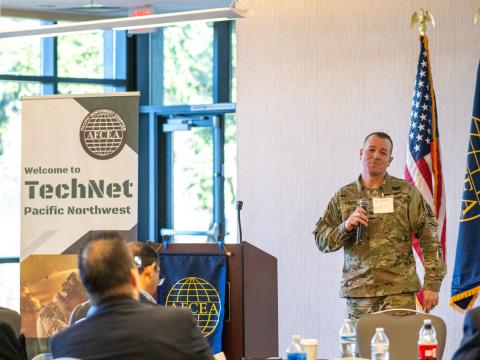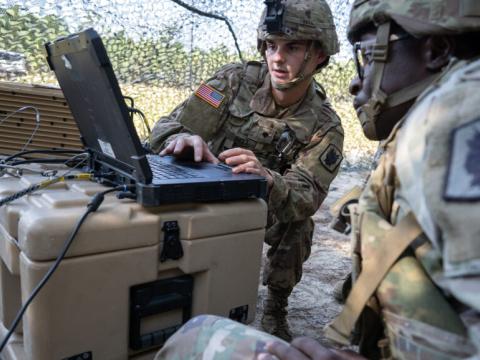In-Motion Connectivity Unifies Information Grid
Mobile routing creates seamless links, increases situational awareness.
Miniaturized routers have been merged with mobile technology to give the military uninterrupted high bandwidth connectivity to mission-critical data as forces move throughout a theater of operation, all via one small rugged device. The capability could network troops in unique ways and solve defense-identified challenges of achieving seamless communications mobility between networks while addressing what is known as the form factor—maintaining a small device size and configuration. It can provide interoperability within a group as well as among defense organizations.
The Mobile Access Router 3200, developed by Cisco Systems Incorporated, San José, uses mobile Internet protocol (IP), an Internet Engineering Task Force standard that lets users keep the same IP address regardless of how they are connected. According to Kathy Small, senior product manager, mobile access solutions, Cisco Systems, mobile routing software technology enables always-on IP availability that is independent of location, movement or type of connectivity. Users can travel and remain connected to their data, which is a military requirement that supports mission-critical applications.
With mobile IP, a router connects to its home network so a subnetwork, or multiple devices, can roam while still appearing to be on the router’s home network. Mobile devices attached to the mobile router can be any IP-enabled device such as a palm-size computer or cellular telephone. These mobile devices can travel from link to link and maintain communications using the same IP address. Application changes are unnecessary because the solution is at the network layer, providing transparent network mobility.
The size of a square tissue box, the Mobile Access Router works like a mobile node except it allows the entire network to roam. This would enable applications such as mobile access for all aircraft passengers as they travel around the world or for multiple craft to communicate with each other while in formation.
“In the military, they go from using ultrahigh frequency to very high frequency to a variety of layer-2-type connections,” explains James P. Massa, vice president of Cisco’s Global Defense and Space Group. “The wire or the wireless connectivity transport is constantly changing as forces move throughout their theater of operations. The code on the mobile router has to address this movement because the forces have to have flexibility,” he says.
Broken coverage often occurs in traditional nomadic computing when different connections are used—for example, wireless local area networks (LANs) for local data coverage and radio links for soldiers in the field. The datalink then must be re-established, which creates a gap in mission-critical transmissions.
Mobile networking is not the same as wireless or portable networking, Massa contends. In mobile networking, computing activities are not interrupted when a user changes the computer’s point of attachment to the Internet. “It’s one thing to be wireless and another to be mobile where a network can be managed and will allow members to go in and out of the network.”
The Mobile Access Router also is compact and rugged and can be deployed on any mobile platform such as an automobile, airplane, train or submarine. NASA currently is evaluating the technology to see how it would perform in space with additional ruggedization.
“I remember carrying my luggable Compaq computer. It was a marvel in technology because it was about 30 pounds, and I could take it on the plane because it was mobile,” Massa shares. “That’s the difference between 18-inch-rack routing technology and mini-router technology. Now you have the small laptops under a pound and a half, or you have a personal digital assistant. That’s what we’re doing with networking technology. We’re going from something that was mobile, but more like luggable, to something that is truly mobile because it is lightweight.”
The mobile router establishes itself as a mobile IP node that registers itself to a home agent. A tunnel is set up to send packets from the home agent to a “care of” address, another router which acts as a foreign agent, and that router forwards information to the mobile router. A second tunnel also is used once the home agent can communicate with the mobile router. This tunnel connects the home agent directly to the mobile router and sends packets to the mobile networks behind the mobile router. Whenever the mobile node moves, it registers a new “care of” address with the home agent.
The Mobile Access Router also takes advantage of Cisco’s Internet Operating Software (IOS), which has been 15 years in development, Massa says. IOS is a network systems software that provides a common IP fabric, functionality and command-line interface across a network while featuring high levels of availability, scalability and connectivity.
The hardware platform uses two types of cards: the Mobile Access Router card—which is the processor, memory and routing engine—and the interface card. Small reveals that Cisco will be launching two mobile interface cards. The first is a synchronous/asynchronous serial card that would connect to a legacy network such as a single channel ground and airborne radio system, or an enhanced position location reporting system network or a satellite communication (SATCOM) system. The second is a fast Ethernet switch interface card to connect to a wireless network such as the Cisco Aironet 802.11 bridge offering very high bandwidth over short distances, Small says. The military community has expressed interest in 802.11—a family of specifications for wireless local area networks—for use in the tactical arena.
Lt. Col. Harry G. Oldland III, USMC, command, control, communications, computers and intelligence division head, direct reporting program manager, Advanced Amphibious Assault Vehicle (AAAV) Technology Center, Woodbridge, Virginia, notes that the AAAV command variant (AAAVC) must function as a tactical data network (TDN) node in the U.S. Marine Corps’ information architecture. However, the TDN uses the Cisco 7200 router. “Because of the harsh environmental requirements of the AAAV, a standard commercial router is unacceptable for us,” he explains. “Working closely with Cisco, our engineers have been successful in integrating the Mobile Access Router into the AAAV(C) network. The primary benefit is that we can maintain an identical network architecture to all of the other Marine Corps TDN nodes. This simplifies integration and training. The size, power consumption and weight are also advantageous given our requirements in the AAAV.” The colonel says that the Mobile Access Router has not shown a noticeable difference in base capabilities from its Cisco 7200 sibling.
“We’ve seen interest in all branches of the service,” Small notes. “We’ve seen personal communication systems that combine the Mobile Access Router with a SATCOM radio carried around in a briefcase for the truly mobile individual in the intelligence community. Another example is a pilot project in the U.S. Defense Department to connect planes when they fly in formation to achieve a flying LAN of 20 planes.”
While the product is new, Small says Cisco already is looking at a road map for the Mobile Access Router. “We’ve seen a great deal of interest in supporting voice,” she offers. The initial problem the company was trying to solve concerned enabling data communications for network-centric warfare. “Today we have a lot of voice solutions that have been deployed, but we initially were focused on enabling data in the battlefield for information exchange and situational awareness.”
“The applications that will follow, the types of things we’ve been talking about in our science fiction novels, are things we haven’t been able to do because we haven’t been able to get enough connectivity speed to the soldier,” Massa concludes. “As we achieve needed speed and assured connectivity, we can start to do things such as monitoring the well-being of the soldier or of a vehicle and being able to report back on their status.”




Comments